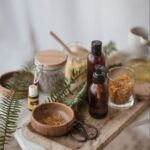For centuries people have relied on fermentation not only to preserve food but also improve it’s texture, palatability and make it easier to digest. Long before refrigeration families in Europe prepared barrels of Sauerkraut to survive the cold winters. In Asia, Kombucha and Miso were part of daily meals, valued for strength and vitality. While in Africa, raw milk, Sorghum and millet porridge were left to ferment gently into tangy nutritious staples like Amasi or Uji Chachu nourishing whole communities.
All these traditions tell stories that harnessed the invisible craft of fermentation and brought forth similar products with different names, depending on the region or country.
Today, these foods are grouped into Probiotics; super foods that are readily available in the market albeit a little expensive for daily consumption, hence the reason you should learn to make them at home.
What happens in Fermentation?
Fermentation is the natural process where micro organisms like bacteria and yeast break down sugars and starches into acids, gases or alcohol, helping the food last longer and making it healthier. The foods are transformed into a unique sourness, fizz and tangy flavour.
When done correctly, fermentation enhances flavor and transform the food to probiotics that benefit digestion, skin, energy and immunity.
FACT: All probiotic foods are fermented, but Not all fermented foods are probiotics. If the fermented food still contains live, active cultures when you eat or drink it, it’s probiotic; if the microbes have been killed through pasteurization, it’s just fermented.
For example: Pasteurized sauerkraut or yogurt has been heated to kill microbes thus it’s fermented but no longer probiotic.
READ MORE ABOUT FERMENTED FRUITS HERE.
Why your body needs Probiotics
Probiotics Vs Prebiotics.
Probiotics are good bacteria and yeasts that keep your gut healthy, found in foods like yogurt, kefir, and kombucha.
Prebiotics are special plant fibers that feed these good bacteria, found in foods like bananas, onions, and garlic.
The two terms are often mixed up, but probiotics add the good microbes, while prebiotics give probiotics food to grow.
Benefits of Probiotics at a Glance.
- Eases symptoms of irritable bowel syndrome (IBS) like bloating and constipation by supporting digestion.
- Clears acne and brightens skin by calming gut inflammation. Helps with acne, eczema and other inflammatory skin conditions.
- Strengthens immunity against infections. May reduce symptoms of seasonal allergies and eczema in children.
- Boosts energy by improving nutrient uptake.
- Helps balance weight and cravings naturally.
- Lifts mood and reduces stress through the gut-brain connection hence recommended for autism management.
- Can help reduce gum disease, cavities, and bad breath by balancing mouth bacteria.
- Promotes women health by balancing yeast and bacteria for vaginal health.
- May reduce urinary tract infections (UTIs) in some cases.
- Helps to restore healthy gut bacteria and reduce diarrhea especially after using antibiotics or infections.
The Process of Making Probiotic Foods.
Types of Fermentation:
- Lactic Acid Fermentation.
Sugars are turned into lactic acid by beneficial bacteria. This preserves vegetables and milk while giving a sour tang. Examples: Yogurt, Sauerkraut, Kefir. - Alcoholic Fermentation.
Yeasts convert sugars into alcohol and carbon dioxide. Seen in brewing and in the first stage of kombucha. Other examples: Beer, wine cider. - Acetic Acid Fermentation
Alcohol is further converted into acetic acid by bacteria, creating a vinegar-like sharpness. Examples: Palm wine, Apple cider vinegar (ACV), Rice wine. Fermentation Conditions: Aerobic vs. Anaerobic.
Some ferments thrive with oxygen, while others need protection from it. How you cover your jars makes all the difference:
Anaerobic (without oxygen):
Used in yogurt and sauerkraut. Secure the lids to keep air out. Ingredients must also stay submerged under the liquid.
Aerobic (with oxygen):
Cover the container with a breathable cloth(cotton), to let air in while keeping out dust and insects.
It’s needed for Kombucha, where the SCOBY breathes at the surface.
Mixed; Aerobic and Anaerobic:
Kefir sits in a closed jar but needs space for gases to escape, Therefore a loose lid works best.
General Rules for Successful Fermentation
- Use glass jars or ceramic crocks, not aluminum or scratched plastic.
- Keep food submerged when oxygen must be excluded.
- Use cloth or loose lids for oxygen-loving ferments.
- Stir or handle with clean utensils, preferably wooden because they are non reactive to acids.
- Rely on your senses: good ferments smell pleasantly sour, never rotten.
Common Probiotics that can be made at home.
- Yogurt
This is perfect for beginners because it is one of the simplest ferments. A staple across many cultures known to support digestion.
Health Benefits of Yogurt : Promotes digestive health by calming gut inflammation, reduces bloating, strengthens bones, improves skin clarity and supports immunity.
How to Make Yoghurt:
One litre raw cow or goat milk.
Two tablespoons plain yogurt (with live cultures).
Glass jar or ceramic bowl.
Method:
- Heat the milk until nearly boiling, then cool to body temperature.
- Stir in the yogurt starter.
- Cover and keep in a warm place for 6 to 8 hours.
- Enjoy your plain yoghurt or chill it in the fridge. You can add cut fruits of your choice for extra flavour.
Good signs: Smooth, tangy, thick.
Bad signs: Rotten odor, slimy texture, mold.
- Sauerkraut.
The Simple Vegetable Ferment is made of cabbage and salt only. Originally made by ancient Chinese with whole cabbage and rice wine to preserve cabbages, the skill spread to Germany. They popularized and refined it over time making it a staple of German cuisine called fermented cabbage ( Sauerkraut), which is why people often think of it as German.
It’s a valued probiotic for improving nutrient absorption.
Health Benefits of Sauerkraut : Enhances gut bacteria balance, supports immunity, rich in vitamin C, vitamin K and brightens dull skin.
How to Ferment Sauerkraut:
1 medium cabbage
1 tablespoon salt: Add salt as you would when cooking similar size of cabbage.
Large glass jar with lid.
Method:
- Shred cabbage into small pieces,put it in a bowl where you add salt and massage it until juices are released.
- Pack tightly into the jar so that the liquid covers it. Use a wooden spoon.
- Weigh it down, cover loosely and ferment for at least 5 days. Keep tasting it to achieve your preferred taste, up to 3 weeks.
Good signs: Tangy smell, bubbles, crisp texture.
Bad signs: Foul odor, slime, dark mold.
- Kefir
The quick probiotic drink ready in 24 hours. It originated from the Caucasus Mountains, so you’ll find variations in pronunciation depending on the country.
Kefir gives you more probiotics than yogurt. Health Benefits of Kefir: Improves digestion, boosts immunity, may reduce inflammation, can help balance appetite and weight while supporting immunity.
How to Make Kefir.
2 cups raw cow or goat milk.
1 to 2 tablespoons Kefir grains.
Glass jar and cloth or loose lid.
Method:
- Place Kefir grains in a jar and cover with milk.
- Cover with lid lightly or cloth secured with a rubber band and leave at room temperature for 24 hours.
- Strain out grains and reuse indefinitely for the next batch, in the same process.
Good signs: Tangy aroma, slight thickening, possible separation.
Bad signs: Rotten odor, unusual colors, grains breaking apart.
- Kombucha
The fizzy refreshing tea was prized as a tea of vitality. It originated from China, but the word Kombucha is derived from the Japanese language. Health Benefits of Kombucha: Aids digestion, supports gut health, boosts energy, provides antioxidants and can ease stress thanks to it’s gut-brain effects.
How to Brew Kombucha.
1 litre water
2 to 3 black tea bags, similar amount if loose tea or to your taste.
70 to 100g sugar
1 SCOBY(Symbiotic Culture of Bacteria and Yeast).
1 cup starter tea (previous batch Kombucha)
Large glass jar, cotton cloth cover and rubber band.
Method:
- Brew sweetened tea and let cool.
- Add starter tea and SCOBY then cover with cloth secured with rubber band.
- Leave for 7 to 10 days. Keep tasting to achieve your preferred taste.
- For natural fizz, bottle for a short second fermentation, around 3 to 7 days, depending on preferred strength of the flavour. Here you can add flavour like raw ginger hibiscus etc.
Good signs: Vinegar-like aroma, bubbles, new SCOBY forming at the top( baby SCOBY).
Bad signs: Mold on surface, putrid rotten smell, SCOBY doesn’t hold together.
General Fermentation Checklist
- Glass jars or ceramic crocks
- Wooden spoon or spatula.
- Lids or cloths plus rubber band to secure the cloth cover.
- Plastic strainer (for Kefir)
- Glass bottles (for kombucha).
Overall, Probiotics mainly shine in gut-related, immune and inflammatory conditions. Now that you know this, challenge yourself to adopt this healthy lifestyle that is more affordable and healthier if done at home without any additives. Start with yogurt for confidence, then try sauerkraut for your first long ferment. Move on to Kefir for daily probiotic support and finish with Kombucha once you’re ready for a longer fizzy challenge.
You can get creative by using fresh fruits to produce different flavours for your Yoghurt and Kombucha. Be observative to notice how air, time and microbes shape each food along the process. Always document the measures and process for easier adjustments duplication. Who knows, within no time you might become an expert in food fermentation, creating a new probiotic in the market.
The world needs more of these healthy ferments to heal the gut of various digestive issues caused by overly processed foods that have messed up our daily nutrition.







